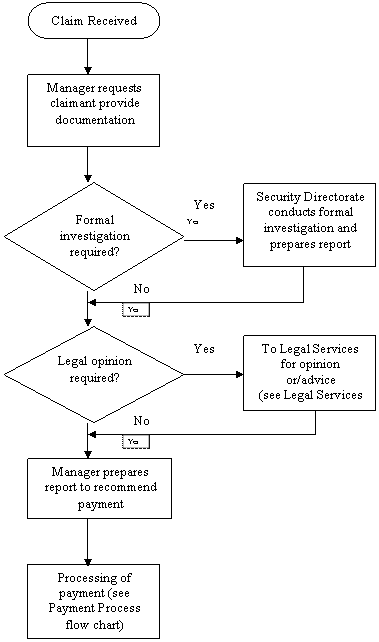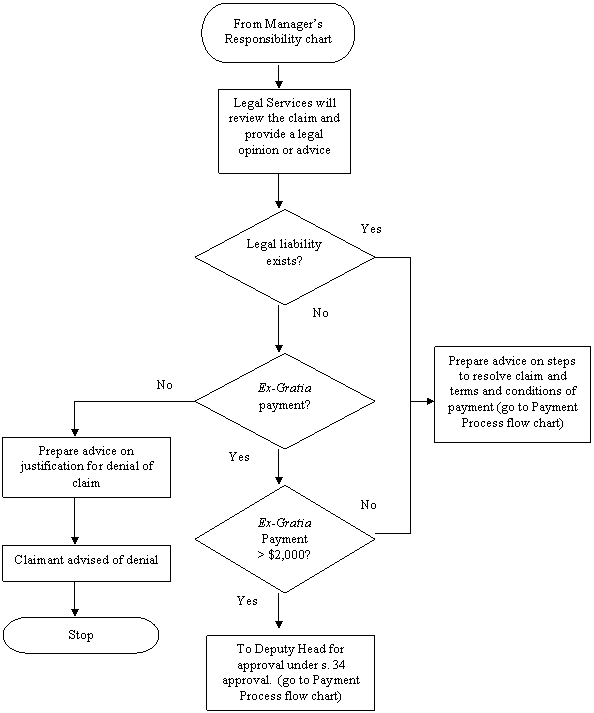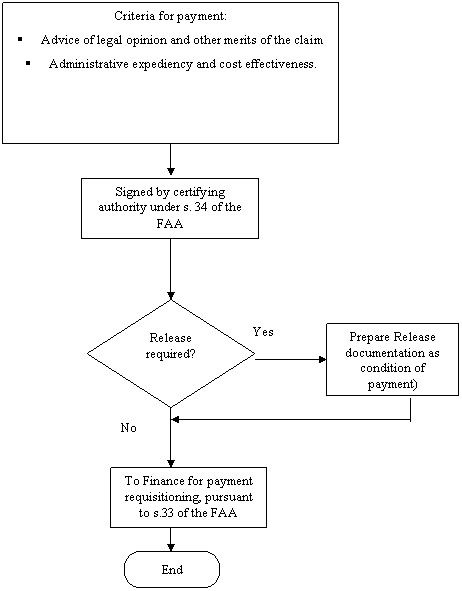Rescinded [2018-05-29] - Guideline on Claims and Ex Gratia Payments
This page has been archived on the Web
Information identified as archived is provided for reference, research or recordkeeping purposes. It is not subject to the Government of Canada Web Standards and has not been altered or updated since it was archived. Please contact us to request a format other than those available.
1. Effective date
1.1 This guideline takes effect on October 1, 2009.
1.2 It replaces appendices A, B and D of the Policy on Claims and Ex Gratia Payments (revised June 1, 1998)
2. Context
2.1 The purpose of this guideline is to assist managers and staff to make better decisions and increase the efficiency, expediency and timeliness for settling and paying of claims by or against the Crown and against its servants and for processing ex gratia payments.
2.2 This guideline supports the Directive on Claims and Ex-Gratia Payments (hereafter referred to as the Directive).
2.3 Though this guideline elaborates on the Directive, it does not present any new mandatory requirements.
2.4 Claims can be classified as follows:
Claims within a department
When an incident resulting in damage to public property occurs within a department, compensation and restoration are the responsibility of the department. In very exceptional circumstances, interim financing may be available through Treasury Board Contingency Vote 5.
Claims between departments
As established under the Directive, one department of government cannot claim damages and receive payment from another department of the same government; therefore, as a general rule, damages are dealt with in a manner that precludes departments from seeking damages from each other (e.g., on the basis of mutual forbearance).
Claims between departments and Crown corporations
The Directive does not apply to claims between departments and Crown corporations. Nevertheless, parties to such claims are encouraged to arrive at a negotiated settlement. When a claim is pursued, it is recommended that each party voluntarily supply the other with all information in its possession.
When it is found impossible to agree by correspondence on the claim's merits and liability, it is recommended that legal officers of the department and of the corporation attempt to arrive at an agreement.
As established by the Directive, if negotiation fails, the issues of fact and law on which there is disagreement are referred to the Deputy Attorney General of Canada, who could arbitrate the dispute through Department of Justice officials or appoint a third party to arbitrate the dispute.
2.5 Exceptions include the following:
- The Directive does not apply to the relocation of household property and travel claims, or to the traditional remedies for settling bidding or contract performance disputes. These are treated in the Treasury Board's NJC Relocation Directive, Travel Directive and Contracting Policy.
- However after reviewing or applying traditional remedies in a contracting case, if there exist exceptional circumstances and the Crown has no liability, an ex gratia payment may be considered under the Directive. The approval of such a payment would be subject to the deputy head's discretion to designate authorized officials and determine the need for a legal opinion, while also taking into account the Directive's requirements governing liability and ex gratia payments and the sensitive nature of ex gratia cases.
- Claims for recovery of losses of public money are governed by the Directive on Losses of Money and Property.
3. Definitions
Definitions of terms used in the guideline can be found in Appendix A of the Directive.
4. General
4.1 After an incident has occurred risk management is a normal part of dealing with any claim that may arise between a department and other entities.
4.2 A claim might result in an amount due (or alleged to be due) or the launch of an action for damages sustained by the Crown or a claimant.
4.3 A clear distinction is drawn between settlement and payment of a claim. Settlement is the process whereby an agreement is reached through negotiation between the respective parties. Payment is the disbursement of money in respect of the settlement or a judgement of the relevant court.
4.4 Generally, claims are broadly categorized as those in tort and those in contract.
4.5 Claims in tort are those for which there is no form of written, oral or implied contractual agreement between the Crown and claimants and for which the Crown may be liable, as determined by the Department of Justice.
4.6 Claims in contract are to be dealt with according to the terms of the contract and the applicable law. Departments are to ensure that the interests of the Crown are protected and all legal rights are exercised.
4.7 When a claim is made in tort (all provinces except Quebec) or extra-contractual liability (Quebec only), it is subject to the requirements of the Directive on Claims and Ex-Gratia Payments.
4.8 Generally claims by or against the Crown or against its servants are negotiated without recourse to the courts by, or in conjunction with, the Department of Justice in accordance with the relevant authorities and procedures.
4.9 A high level overview of the process for claims by the Crown and claims against the Crown is included in Appendix B and Appendix C, respectively.
5. Claims under the Canadian Human Rights Act
5.1 The negotiation and payment of settlements and Tribunal Orders under the Canadian Human Rights Act (CHRA) are subject to the requirements of the Directive whereas the CHRA applies with respect to investigation and conciliation requirements.
5.2 The Directive's requirements do not apply to equal pay for work of equal value complaints lodged under section 11 of the CHRA. Such complaints are dealt with through Treasury Board personnel policy or other separate authorities.
5.3 A discriminatory practice, as defined by the CHRA, is not a tort, though it is recommended that departments deal with a complaint lodged under the CHRA as if it were a tort.
5.4 For Tribunal Orders which are made Federal Court Orders, the Federal Courts Act stipulates that payments are a statutory charge against the Consolidated Revenue Fund.
5.5 Deputy heads may designate payment approval authorities within their departments consistent with departmental practices and the sensitive nature of human rights issues.
6. Investigations
6.1 As established by the Directive, departmental security officers (DSO) are generally responsible for conducting or directing departmental claims investigations or assisting managers with the conduct of such investigations except when departments have special organizations established for this purpose. DSOs are also responsible for dealing with the appropriate law enforcement agency on such cases. Claims investigations are based on the type of incident and the dollar amount involved.
6.2 Further to the Directive's requirement that managers investigate incidents that could lead to a claim by or against the Crown or against a servant, it is recommended that the investigation be conducted at the earliest reasonable opportunity and that a report be prepared. While the level of investigation is to be commensurate with the dollar amount involved, it is recommended that the investigation includes, as is appropriate, the following:
- A full statement of the duties and responsibilities of any servant involved;
- Detailed information relating to the use of the Crown property and the relevant authority for such use;
- Statements about the incident from servants and other persons having any knowledge of the circumstances;
- Copies of any reports made to the police in connection with the incident;
- A complete account of the incident including a who was involved, what happened, where it happened, when it happened, how it happened and why it happened;
- Plans, sketches or photographs, as necessary, to contextualize or explain the nature and extent of the incident;
- Any additional information and material that may be required for a legal opinion;
- The assistance of the Royal Canadian Mounted Police; and
- The assistance of private sector claims adjustment services or collection agencies.
7. Claims against the Crown and ex gratia payments
7.1 Claimant's position
Under the Directive, when a claim is made against the Crown for an incident, managers are responsible for, without prejudice and without admitting liability, requesting the following from the claimant:
- A detailed statement of the facts upon which the claim is based;
- A detailed statement showing how the claim is calculated; and
- Original copies of documents confirming all disbursements.
7.2 Legal opinion
When claims, including the report of the investigation and any information received from the claimant, are referred to Legal Services in compliance with the Directive, it is recommended that the legal opinion requested address the following:
- Liability of the Crown;
- The steps, if any, to be taken to resolve the claim, bearing in mind the cost-effectiveness of any such steps; and
- The terms and conditions on which it would be advisable to resolve the claim, when it is advisable to settle.
7.3 Claims for servants' effects
Under the Directive, managers are to conduct investigations of reported incidents involving claims for servants' effects that are damaged, lost, stolen or destroyed. Claims for servants' effects are not to be treated as ex gratia payments. It is recommended that managers apply the following criteria to determine liability for payment:
- Servants' effects include only those items that are considered to be reasonably related to the performance of a servant's duties at the time of the loss or damage; and
- Compensation is based on the full cost to replace the effects with effects of the same or equivalent quality or the reasonable cost to repair them, whichever is most appropriate.
7.4 Ex gratia payment
As required under the Directive, managers with delegated authority to requisition payment are responsible for considering the following when deciding whether to make an ex gratia payment:
- Compensation from other sources, such as federal or provincial statutes, private or public programs, contract provisions and commercial insurance or recovery from third parties;
- The Directive is not used to fill perceived gaps or compensate for the apparent limitations in any act, order, regulation, policy, agreement or other governing instruments-if, for example, a particular subject is governed by another instrument and that instrument does not provide for such a payment, the Directive cannot be used to expand that instrument and an exception to the governing instrument would need to be sought;
- If there does not appear to be a governing instrument, all other possible sources of compensation are reviewed (e.g., statutory or regulatory schemes, other Treasury Board policies or directives, program funding, and grants or contributions);
- Payment may be made ex gratia if, after the review, there is no other source of funds or the sources provide incomplete compensation, no liability on the part of the Crown, and no limitation, restriction or prohibition imposed in existing schemes; and
- The amount of the payment may be reduced when the acts or omissions of any person, including persons for whom a payment is being considered, contributed to the damages or loss incurred.
7.5 Releases
In compliance with the Directive, managers are to obtain a release in consideration of payment for a negotiated settlement, except when it would not be administratively expedient and the manager is confident that the payment will resolve the claim. The release may be in the form shown in Appendix A, or as directed by Legal Services. For ex gratia payments, a release is not normally required.
7.6 Disbursements
Further to the Directive's disbursement requirements, in accounting for disbursements related to claims against the Crown and ex gratia payments, managers with delegated authority to make payments are responsible for considering the following:
- Part II of the Crown Liability and Proceedings Act requires that judgements against the Crown in either federal or provincial court for matters falling within the scope of this Act be paid out of the Consolidated Revenue Fund as statutory expenditures upon production of a certificate of judgement, pursuant to section 30.(1). Judgements against the Crown in the Supreme Court of Canada are likewise payable out of the Consolidated Revenue Fund, pursuant to section 98 of the Supreme Court Act. Money paid on behalf of departments from the Consolidated Revenue Fund will eventually be accounted for either by transferring funds from a departmental appropriation or by seeking supplementary funding.
- Crown witness, travel, and legal fees and other expenses incurred by, or on behalf of, the department when preparing, prosecuting or defending a court case, out�of�court settlements and liability and ex gratia payments are charged to the appropriation of the relevant department.
- Costs awarded against the Crown by a judgment are paid as directed by the court. Court awards are charged to the appropriation of the relevant department.
- It is important to recognize the distinction between a judgment in a proceeding brought before a court and a decision of a judge acting in a non-judicial capacity. Just as a judge is often appointed as a Commissioners of Inquiries or an arbitrator in labour disputes, a judge may likewise be appointed as an assessors or arbitrator under various acts. A decision by a judge under, for example, section 57(3) of the Health of Animals Act or section 41(3) of the Plant Protection Act is not a court award and is not covered by the statutory authorities for court judgements.
8. Claims by the Crown
8.1 Crown's position
In compliance with the Directive, managers are responsible for making every reasonable effort to obtain value for money when resolving claims by the Crown. It is recommended that managers take into account administrative expediency and cost-effectiveness when resolving such claims.
8.2 Legal opinion
In compliance with the Directive, managers are responsible for referring all claims involving legal proceedings to Legal Services and obtaining a legal opinion when material sums are at stake or when there is a lack of or conflicting evidence or uncertainty as to the applicable legal principles.
8.3 Recovery from servants
A situation may arise wherein the Crown has a claim against a servant for which the servant is not indemnified under the Policy on the Indemnification of and Legal Assistance for Crown Servants. Under the Directive, when this happens and before recovery of the claim amount either by deduction from or set�off against any money that may be due or payable by the Crown to the servant, managers are responsible for the following:
- Notifying the servant of the proposed retention and of his or her right to make representation within 30 days; and
- Considering the servant's representation, if any, before making a final decision.
8.4 Revenues
As required under the Directive, managers are responsible for collecting or enforcing payment on a claim made by the Crown in compliance with the Directive on Receivables Management and the Directive on Receipt, Deposit and Recording of Money. The money collected, including any insurance proceeds, is deposited to the credit of the Receiver General and not credited back to an appropriation unless:
- The recovery is a claim for loss or damage to a Crown asset, which according to section 39 of the Financial Administration Act, may be credited to the appropriation against which the related expenditure was charged provided the expenditure and recovery occur in the same fiscal year; or
- There is revenue spending authority.
8.5 Release
As established under the Directive, managers with delegated authority to resolve claims may sign a release as a condition of payment being made to resolve a claim by the Crown.
Appendix A — Release
Know all persons by these present that (name and address of claimant) does hereby remise, release and forever discharge Her Majesty the Queen in right of Canada and (name of any officer or servant of the Crown involved), from all manners of action, claims or demands, of whatever kind or nature that (name of claimant) ever had, now has or can, shall or may hereafter have by reason of damage to or personal injury, or both, (here set out subject matter of the damage) as a result of or in any way arising out of (here set out incident and the date, time and place of occurrence).
It is understood and agreed that this Release shall only be effective when payment will have been made on behalf of Her Majesty to (name of claimant) of the sum of $________.
It is also understood that Her Majesty the Queen in right of Canada does not admit any liability to (name of claimant) by acceptance of this Release or by payment of the said sum of $________.
Signed, Sealed and Delivered in the Presence of
Witness: |
For the (department or agency name): |
|---|---|
IN WITNESS WHEREOF, I have hereunto set my hand and seal this ________ day of _______, 20____. |
IN WITNESS WHEREOF, I have hereunto set my hand and seal this ________ day of _______, 20____. |
Print Name _________________________ |
Print Name _________________________ |
Signature _________________________ |
Signature _________________________ |
Phone number (_ _ _) _ _ _ - _ _ _ _ |
Phone number (_ _ _) _ _ _ - _ _ _ _ |
|
|
Witness: |
For the Claimant or person duly authorized for the Claimant: |
IN WITNESS WHEREOF, I have hereunto set my hand and seal this ________ day of _______, 20____. |
IN WITNESS WHEREOF, I have hereunto set my hand and seal this ________ day of _______, 20____. |
Print Name _________________________ |
Print Name _________________________ |
Signature _________________________ |
Signature _________________________ |
Phone number (_ _ _) _ _ _ - _ _ _ _ |
Phone number (_ _ _) _ _ _ - _ _ _ _ |
Appendix B — Claims By the Crown
Manager |
Legal Services |
Appendix C — Claims Against the Crown
© Her Majesty the Queen in Right of Canada, represented by the President of the Treasury Board, 2017,
ISBN: 978-0-660-09563-9





